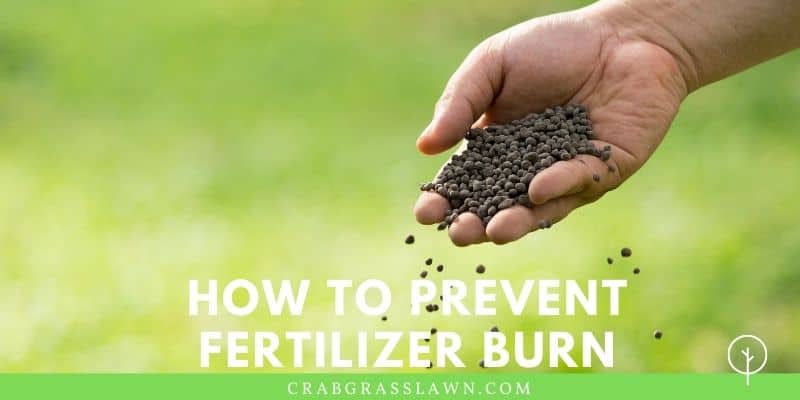Have you heard the saying “if some is good, more is better”? Well, this statement certainly doesn’t apply to fertilizers. Fertilizer burn is a real thing and it’s really bad for your grass.
Just like you and me, grass and plants can only absorb the nutrients they need from their food—fertilizers, which is determined by a few factors including the amount of light they receive, quantity of water available, and temperatures they are grown in.
If you eat too much food, it can cause serious problems, and similarly can cause fertilizer burn in grass and shrubs.
Simply put, fertilizer burn happens when plants receive more fertilizer than they can process. On a brighter note, it’s possible to reverse the effects of fertilizer burn, but on the downside, does take time for the plants to return to full health.
Signs of Fertilizer Burn

The symptoms of fertilizer burn tend to appear within a day or two or may take several weeks if you apply slow-release fertilizer.
There are myriad symptoms of fertilizer burn, most notably spots that are browning, yellowing, withering, or discolored streaks where the fertilizer was applied. However, it’s worth noting that there are several other causes of browning or yellowing grass.
The most recognizable symptoms of fertilizer burn are discoloration on the edges of leaves, and stunted or excessive growth of foliage with fewer blossoms.
But the most severe damage isn’t done to the foliage, but occurs underground in the roots. Excess salt in fertilizers can draw moisture away from plant roots and tissues, which can cause burns at the root level.
And since the plants can’t get the water they need, the roots become weakened against disease, and cause the leaves to turn yellow or brown, and eventually die
How to Treat Fertilizer Burn?

If you notice any signs of fertilizer burn in your plant leaves and roots, you need to take action immediately to help correct the problem and create the best environment for recovery.
The first, and most important thing to do is stop any fertilization efforts, even if it means pausing your regular fertilizer schedule for your lawn.
If you’ve applied granular fertilizer, remove any visible granules from the soil surface, and any slow-release fertilizer spikes currently embedded into the dirt.
Next, move your plants to a cooler area that’s away from the sun’s heat. Your plant’s root system absorbs more nutrients in hot, sunny locations, which can increase the chances of fertilizer burn.
Potted plants are easy to move around, but not grass, for which you can spread some mulch around the base of the grass to protect the soil’s moisture, and also help keep the roots cool.
To repair burnt grass from fertilizer, your lawn will need a generous amount of water to get back to lush green. Adding to this, it’s also important that you water your lawn as soon as you notice any yellow or brown patches to prevent further damage.
If the burn-affected areas of your lawn don’t turn green in a couple of weeks, you may have to dig them up and overseed. Here are a few key steps to overseeding a lawn.
You may also want to perform a process called leaching, which entails removing the excess nutrients and salt from the soil via watering.
However, before you perform leaching, it’s important to check for white crust that’s usually located at the surface of the soil.
If you water these solid soluble salts, they can make their way easily to the roots of the plants, and make things worse than what they already are.
Most times the crust is hard enough to pick in large chunks, but be careful not to remove too much soil along with the crust.
For in-ground plants, provide enough water to moisten the soil past the root level, which in most cases is between 8 – 12 inches.
The leaching application should be repeated a second time, after approximately a couple of hours after the initial application.
Two applications should get rid of the excess fertilizer salts, after which you can return to your standard fertilization schedule.
Fertilizer burn may often cause dead foliage, and since these leaves aren’t going to benefit from any further fertilizer applications should be removed. After the plant recovers from fertilizer burn, it will produce new and healthy foliage.
How to Prevent Fertilizer Burn?

Fertilizer burn can be easily prevented by simply reading the label on fertilizer products, and using them according to manufacturer directions.
Labels on leading products indicate application methods, appropriate rates, and the conditions to prevent lawn and plant damage.
As mentioned earlier, applying more fertilizer is not always the best practice, because fertilizers do contain salts and other nutrients, which are digested by plants at a certain rate.
When fertilizing an area, it’s a good idea to take accurate measurements to prevent over-application.
Further, you should avoid the guesswork of fertilizer quantities by using a proper measuring cup. In fact, you should have a set of measuring cups for fertilizer use only, and take the time to measure the product before application.
Fertilizer can easily leak out of the spreader hopper when filling, stopping, or turning. You can either close the hopper when performing these actions or be extra careful as even the smallest amount of excess fertilizer can cause fertilizer burn.
Plants that are already suffering from bad health due to poor soil or weather conditions won’t be able to process fertilizer normally.
Instead of nourishing your plants, applying fertilizer can adversely affect the condition of ill plants, which is why it’s important to wait until the plants are in good health before fertilizer application.
Final Thoughts
Fertilizer burn can happen to even the healthiest lawns but can be easily prevented if you fertilize your lawn and garden properly. And always stick to a fertilizer schedule.
Applying excess fertilizer more than the plants can process is the common reason for fertilizer burn, which is why it’s highly important to read and understand the manufacturer label before fertilizer application.
Fertilizers are available in myriad different forms, starting from concentrated liquids to dry granules, so what works for your neighbor, may not deliver the same results for your lawn.
If you’re just getting your feet wet with fertilizers, or aren’t sure about which fertilizer is right for your lawn, please leave a comment below.
Hi, Alex Kuritz here. Growing up I remember that my family had one of the best lawns in the neighborhood. Richly green and lush. I did a lot as I grew up in terms of caring and tending for not only my family’s lawn but also my neighbors. I can say I have years of experience, and I am here to share it with you.


